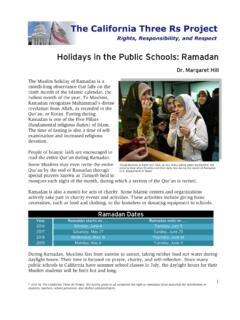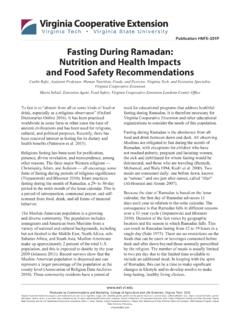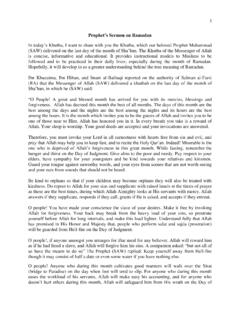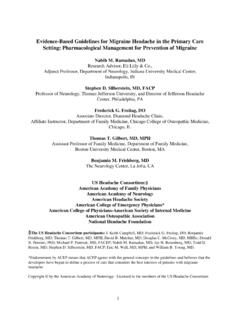Transcription of Caring for Muslim Patients Who Fast in Ramadan
1 640 American Family Physician Volume 91, Number 9 May 1, 2015 Caring for Muslim Patients Who fast During RamadanCommentary by TASNIM KHALIFE, MD; JESSIE M. PETTIT, MD; and BARRY D. WEISS, MD, University of Arizona, Tucson, ArizonaCase scenarios are writ-ten to express typical situations that family physicians may encounter; authors remain anony-mous. Send scenarios to Materials are edited to retain confidentiality. This series is coordinated by Caroline Wellbery, MD, Associate Deputy collection of Curbside Consultation published in AFP is available at Case ScenarioA 68-year-old Muslim man who was recently diagnosed with type 2 diabetes mellitus pre-sented for a routine health visit.
2 His initial A1C level was , which decreased to after dietary changes, exercise, and treatment with metformin (Glucophage). He stated that he wanted to fast during Ramadan and requested advice on how to manage his dia-betes while fasting. Because our clinic serves a large Muslim community, we have been seeking more general guidelines for advis-ing vulnerable individuals and Patients with medical conditions on a safe approach to fasting. What recommendations should we make to Patients to maintain health while fasting during Ramadan ?
3 CommentaryRamadan is a holy month during which Muslims fast from eating, drinking, sexual intercourse, smoking, and all vices from dawn until ,2 The fast of Ramadan is one of the five pillars of Islam. It is an obli-gation for all healthy adult Muslims, with a focus on spiritual and physical well-being to strengthen one s relationship with God. Because it is based on a lunar calendar, the dates of Ramadan vary each year. In 2015, Ramadan is expected to occur from June 18 to July 17.
4 VULNERABLE GROUPS WHO OBSERVE FASTINGThe Quran exempts the sick from ,2 According to Islamic scholars, persons exempt from fasting include individuals with illnesses that might be exacerbated by fasting ( , diabetes), women who are pregnant or breastfeeding, prepubertal children and adolescents, and those on medication regi-mens that would be affected by fasting. Other groups exempted from fasting include those with disabling mental illness or developmen-tal disabilities, menstruating women, women with postpartum bleeding, older persons, and Muslims who are exempt from fast -ing nonetheless choose to fast .
5 Clinicians should be able to provide advice on how such Patients should safely approach the , an estimated 40 to 50 million Patients with diabetes fast during Ramadan , including nearly one-half of those with type 1 diabetes and most of those with type 2 ,3 Patients with diabetes who choose to fast require close blood glucose monitor-ing because there is an estimated increase in severe hypoglycemia for those with type 2 Other risks of fasting with diabetes, particularly when medications are withheld, include hyperglycemia, diabetic ketoacidosis, hyperosmolar hyperglycemic state, dehydration, and deep venous ,4 Clinicians should explain warning signs for these conditions to Patients and instruct them to break the fast and seek medical attention if symptoms occur.
6 Specific recommendations in the lit-erature provide risk stratification criteria to determine whether fasting is safe for Patients with ,4 Fasting is unsafe for Patients with type 1 diabetes, but is generally considered safe for Patients with well-controlled type 2 diabetes treated with oral agents. To avoid hypoglycemia, certain medications require dose adjustment. Met-formin should be dosed twice daily with one-third of the total daily dose taken at the predawn meal and two-thirds at the larger evening ,4 For sulfonylureas dosed twice daily, halving the predawn dose Curbside Consultation Downloaded from the American Family Physician website at Copyright 2015 American Academy of Family Physicians.
7 For the private, noncom-mercial use of one individual user of the website. All other rights reserved. Contact for copyright questions and/or permission Consultation642 American Family Physician Volume 91, Number 9 May 1, 2015should be ,4 Any oral agents dosed once daily should be taken at the eve-ning meal. Thiazolidinediones, dipeptidyl-peptidase-4 inhibitors, and short-acting oral insulin secretagogues do not require adjustment because of the low risk of hypo-glycemia. Patients with type 2 diabetes who are taking long-acting insulin and choose to fast should decrease each dose by 20%.
8 4 In this case scenario, the patient has well-controlled diabetes on metformin mono-therapy. He is in a low-risk category and can safely fast with careful blood glucose moni-toring and dosing adjustment as described AND BREASTFEEDINGI slamic law exempts women who are preg-nant or breastfeeding from fasting, and phy-sicians should recommend against fasting for these Patients . Nonetheless, many preg-nant and breastfeeding women choose to fast during ,6 Women who do so should be advised to hydrate and consume nutritious foods during the predawn and evening meals.
9 Clinicians should also give precautions against excessive daytime activ-ity, and explain the warning signs that war-rant breaking the fast , such as decreased fetal movement, extreme fatigue or dizziness, or nausea with AND ADOLESCENTSThe requirement to fast begins with puberty, so children are exempt from fasting. How-ever, children often fast with their fami-lies for a portion of the day. Postpubertal adolescents generally fast , and those who are unaccustomed to fasting and participate in athletics or spend time outdoors in warm climates require special attention to avoid dehydration.
10 Clinicians can help prevent dehydration by excusing students from phys-ical education classes and advising student athletes to train in the early evening hours, just before or after breaking their oral medications during the fast -ing hours invalidates the fast , and Patients often skip midday doses. Therefore, long-acting forms of medications or twice-daily dosing regimens are options during and subcutaneous injec-tions, eye and ear drops, and routine blood draws do not invalidate the fast .



















